Exploring the Wonders of Planet Saturn
All about planet Saturn: Our journey through space makes us eager to unlock the universe’s secrets. Among the stars, Saturn captures our wonder like no other with its stunning rings, mysterious moons, and mesmerizing storms. Let’s uncover all about planet of Saturn, exploring its past and the recent discoveries that bring us closer.
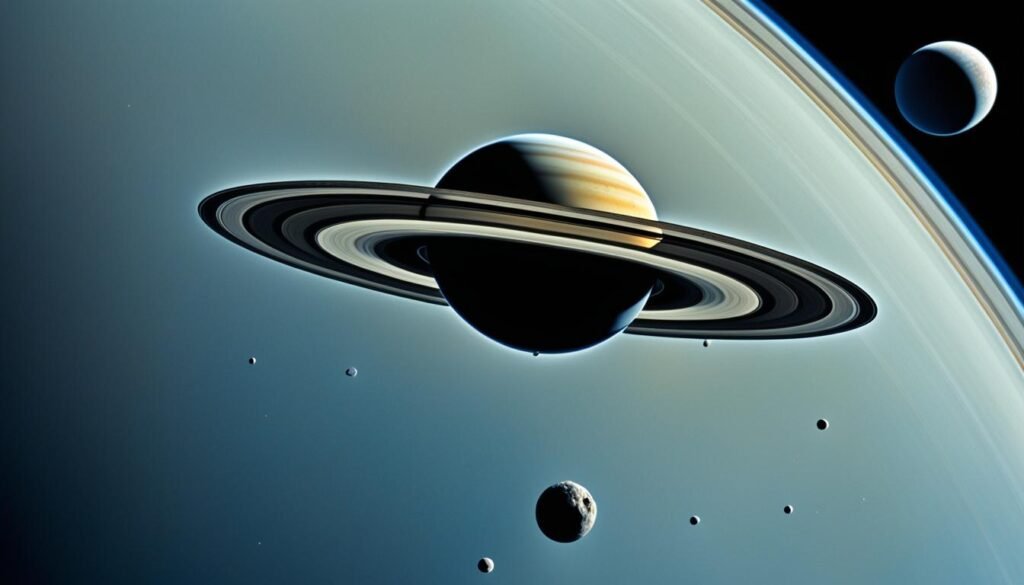
In 1610, Galileo Galilei took a groundbreaking look at Saturn through his telescope. This moment was crucial for our understanding of Saturn’s history. Later, scientists like Christiaan Huygens solved the mystery of Saturn’s Rings. Their work paved the way for our current knowledge, gathered by missions such as Cassini. This probe has revealed much about Saturn facts, including its strong magnetic field and high-speed winds.
Our Saturn exploration adventure shows us the wonder of Saturn’s Moons and its rings, shaped by Mimas. I’ve learned that Saturn is 9 times larger than Earth. These discoveries bring us closer to the Gas Giant, letting us admire Saturn’s beauty like never before.
A Glimpse of Saturn’s Past: Observations Through History
Our quest to understand Saturn began when Galileo first spotted it in 1610. Through his early telescope, he saw something unique. It looked like three bodies together, but it was actually Saturn with its rings. This discovery by Galileo was just the start of our journey into Saturn’s mystery. Soon after, Christiaan Huygens in the 1650s would give us more details. He was the first to explain that Saturn had rings around it. These early astronomers, with their simple tools, greatly expanded our knowledge of the cosmos.
Jean-Dominique Cassini later made major discoveries about Saturn. He found the Cassini Division, a big gap in Saturn’s Rings. This showed us how complex and beautiful Saturn’s Rings are. It also hinted at the gravitational forces at play between Saturn and its moons. These forces shape the formation and look of the rings.
The Cassini mission, launched in 1997, was a big milestone. It took off from Cape Canaveral with 12 scientific tools aimed at exploring Saturn and its moons. After traveling for nearly seven years, it began studying Saturn. It looked at Saturn’s atmosphere, rings, and magnetosphere for 13 years.
- Cassini discovered the detailed structure of Saturn’s rings. Some parts are quite young, between 10 million and 100 million years old.
- In 2005, the Cassini’s Huygens probe did something amazing. It landed on Titan, Saturn’s moon. This was the first landing on a moon other than Earth’s. Titan has methane rain and lakes, making it similar yet different from Earth.
- The Cassini mission has taught us a lot about Saturn. We now see it as a place full of different objects and activities.
| Significant Voyager Discoveries | Cassini-Huygens Facts |
|---|---|
| Voyagers 1 and 2’s flybys in 1980 and 1981 returned tens of thousands of images of Saturn’s rings and moons. | Cassini made very close passes to Saturn, measuring its magnetic and gravitational fields before its deliberate demise in 2017. |
| U.S. Pioneer 11 in 1979 transited Saturn’s ring plane, within 38,000 km of the A ring, and approached within 21,000 km of its atmosphere. | The Cassini spacecraft, weighing nearly six metric tons with propellants, was one of the heftiest interplanetary crafts of its time. |
| Voyager 1 provided groundbreaking data during flybys of Jupiter and Saturn. | By mission’s end, Cassini unveiled the possibility of liquid lakes on Titan and geysers of water ice on Enceladus’s south pole. |
| NASA’s Voyager missions increased the count of discovered Saturn moons from 13 to 31. | As of recent discoveries, Saturn has eclipsed Jupiter with over 145 moons. |
All About Planet Saturn: Delving into the Gas Giant’s Mysteries
Saturn is a mysterious gas giant in space that catches our eye with its beauty. It’s huge and has unique rings, showing how complex the universe is. I’m going to explore what Saturn is made of and look at its atmosphere and rings closely. Saturn is predominantly composed of hydrogen and helium these are 75% and 25% respectively, the two basic gases of the universe. It also bears traces of ices containing a tiny fraction of ammonia, methane, and water.
Unveiling Saturn’s Composition and Atmosphere
- Composition:
- Hydrogen and Helium: Saturn is indeed a gas giant, primarily composed of hydrogen (about 75%) and helium (around 25%). These gases form the bulk of its atmosphere.
- Trace Ices: In addition to hydrogen and helium, Saturn contains traces of ices, including ammonia, methane, and water. These elements add a touch of complexity to its composition.
- Beautiful Bands:
- Saturn’s iconic yellow and gold bands are a result of its rapid rotation and strong winds. These winds create distinct cloud layers at different altitudes.
- The bands are made up of various compounds, including ammonia crystals and other organic molecules. These compounds interact with sunlight, giving Saturn its characteristic colors.
- Heat and Weather:
- The heat inside Saturn comes from its core, where gravitational energy is released as the planet slowly contracts.
- This heat drives powerful convection currents in the atmosphere, leading to the formation of the bands and storms.
- Saturn’s weather patterns are dynamic, with jet streams and cyclones constantly shaping its appearance.
- Storms and Disruptions:
- Saturn experiences massive storms, some of which can disrupt its otherwise calm atmosphere.
- The most famous storm on Saturn is the Great White Spot, which occurs roughly once every 30 years. It’s a colossal disturbance that affects the entire planet.
- These storms can alter the gas distribution, mixing different layers and revealing deeper atmospheric features.
Saturn is a giant made mostly of hydrogen and helium, making it a true gas giant. It has beautiful yellow and gold bands, created by strong winds. These winds come from heat inside Saturn and its weather. Sometimes, big storms disrupt Saturn’s calm, changing the gas in its atmosphere.
What causes Saturn’s rings to be visible?
- Visibility: Even the smallest telescope at 25x magnification reveals Saturn’s rings.
- Separate Structure: A good 3-inch scope at 50x magnification shows the rings as a distinct structure detached from the planet’s ball on all sides.
So, grab your telescope and enjoy this cosmic marvel!
Understanding Saturn’s Temperature and Size
Saturn is massive, more than 755 times the size of Earth. This size impacts its weather, with wind speeds reaching up to 1,800 km/h. Saturn’s clouds are made of ammonia and methane, adding to its thick atmosphere.
Deciphering the Dynamics of Saturn’s Magnificent Rings
Saturn’s rings are made of ice and rock, like a crown floating in space. Most of the ring is ice, with some rock and carbon. We’ve found gaps in the rings, helping us learn more about their structure. The rings have various particles, creating spirals where waves of gravity meet.
Saturn has over 145 moons, including Titan, and strong winds in its rings. This shows how planets change over time. Below, we compare how big Saturn’s rings are and its many moons.

A view of Saturn’s rings from the planet’s surface, with some of its largest moons visible in the background. The rings appear as shimmering bands of icy particles, reflecting the light of the distant Sun. The moons hang low on the horizon, their rugged surfaces illuminated by the warm glow of Saturn’s atmosphere. In the distance, a looming storm cloud hovers over one of the gas giant’s polar regions, casting an eerie blue glow across the scene.
| Characteristic | Data | Significance |
|---|---|---|
| Ring Span | Up to 282,000 km | Illustrates the immense scale |
| Particle Size | Dust grains to meters across | Indicates the diverse composition |
| Satellites | Over 145 | Reflects the complexity of Saturn’s system |
| Largest Moon | Titan | Surpasses Mercury in size, has a thick atmosphere |
| Ring Moons | Estimated 60 within the rings | Demonstrates dynamism within the ring system |
The Spectacular Discovery of Saturn’s Moons
Our journey into space has led to amazing finds about Saturn and its moons. The planet now boasts a total of 82 known moons, thanks to the discovery of 20 new moons. This group includes both prograde and retrograde moons, showing how complex and dynamic their movements are. Titan, Enceladus, and Iapetus stand out among these moons.
Saturn has now surpassed Jupiter, which had the most moons since the 1990s. Jupiter previously had a record of 79 moons. This change highlights Saturn’s fascinating role in our quest to understand space.
The moons of Saturn hold our interest with their unique features. Titan is the biggest and has a thick atmosphere. Enceladus shows signs of organic life under its ice. And Iapetus intrigues us with its mysteries. Together, they give us insight into how moons and planets form and evolve.
To involve the public, a contest is naming the new moons after figures from mythology. This initiative, coupled with the @SaturnLunacy Twitter campaign, brings everyone closer to the excitement of space discovery.
Enceladus especially fascinates scientists. Cassini’s mission found complex molecules there, suggesting it could support life. These discoveries push us to look for life in other ocean worlds, like Europa. We hope future missions will reveal more about these icy realms.
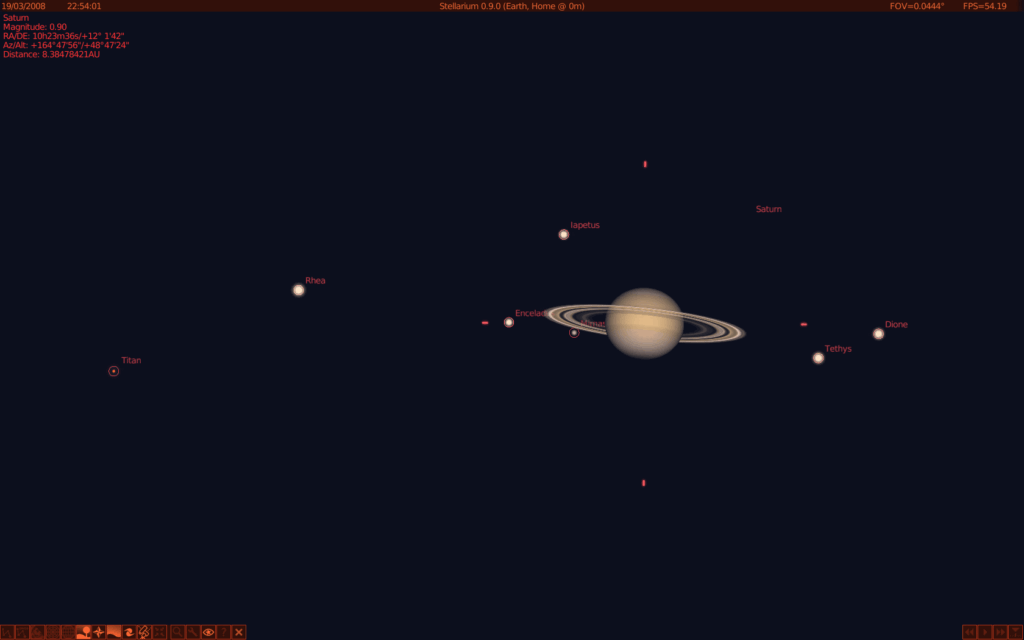
Certainly! Here’s a concise table summarizing some of Saturn’s intriguing moons:
| Moon Name | Orbit Direction | Status | Notable Feature |
|---|---|---|---|
| Daphnis | Prograde | Confirmed | “Ring-maker” moon |
| Epimetheus | Co-orbital | Confirmed | |
| Enceladus | Prograde | Confirmed | Icy geysers |
| Tethys | Prograde | Confirmed | “Death Star” moon |
| Titan | Prograde | Confirmed | Nitrogen-rich atmosphere, hydrocarbon lakes |
| Hyperion | Prograde | Confirmed | Sponge-like moon |
| Iapetus | Prograde | Confirmed | Two-tone coloration |
| Phoebe | Retrograde | ||
| Ymir | Farthest from Saturn | ||
| Pan | Inner moon | Within B and G rings |
Touchdown on Titan: Huygens Probe’s Unprecedented Mission
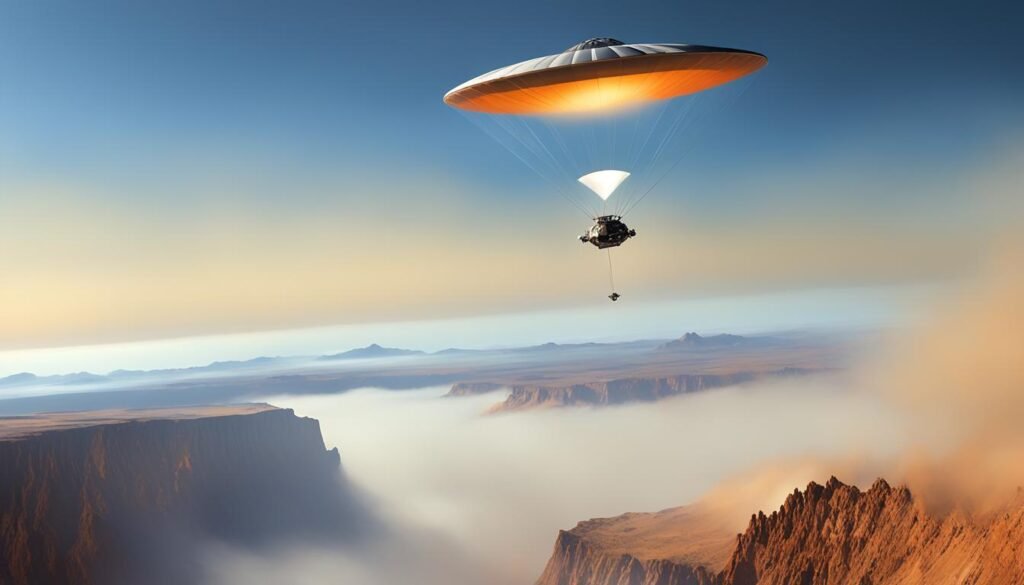
The Huygens Probe descending through thick, orange clouds towards the rugged surface of Titan. The probe’s parachute is fully deployed, casting a shadow on the ground below. In the distance, mountains and canyons can be seen shrouded in mist. The probe’s heat shield glows white hot as it enters the atmosphere, leaving a trail of fire behind it. A sense of excitement and adventure permeates the image as the probe embarks on its journey to uncover the mysteries of Titan.
Our quest to understand space led to a huge achievement: the Huygens Probe landing on Titan. This was part of the Cassini-Huygens mission, costing $3.3 billion. It was a joint effort that explored Saturn’s moons, focusing on Titan. On Jan. 14, 2005, after traveling for 7 years and covering 900 million miles, the probe arrived on Titan’s surface. It was the first craft to land on any moon other than our own.
First Landfall on an Alien Moon
When the Huygens Probe landed, it revealed Titan’s secrets through data. It showed what the moon’s atmosphere and surface were made of. Titan is the biggest of Saturn’s moons. The probe went 789 miles through its thick atmosphere to study the surface, rich in organic molecules.
Analyzing Titan’s Rich Atmosphere and Varied Surface
The Huygens mission had tools to examine Titan’s atmosphere and surface. It confirmed the moon’s atmosphere is denser than Earth’s with a lot of nitrogen and 6% methane. This mix creates unique weather and organic life clues. Despite Titan’s extreme cold, at 290 degrees below zero Fahrenheit, the mission gave us valuable data. It showed us what an early Earth-like atmosphere might have been like.

| Statistic | Value | Impact |
|---|---|---|
| Distance traveled by Huygens | 900 million miles | Farthest human-made spacecraft landing from Earth |
| Temperature on Titan’s surface | 290°F below zero | Highlights challenges for surface exploration |
| Duration of data transmission post-landing | More than 5 hours | Provided extensive information about Titan’s surface and atmosphere |
| Density of Titan’s atmosphere | About 1.5 times denser than Earth’s | Indicates rich presence of nitrogen and methane |
The Pioneering Pioneer 11 and Voyager Missions

The Pioneer 11 spacecraft, launched in 1973, revolutionized our understanding of Saturn. It discovered new moons, detected the “F” ring, and mapped Saturn’s magnetosphere and interior. Its legacy includes crucial insights into Saturn’s composition and atmosphere. It paved the way for the Voyager missions. This journey changed how we see Saturn and its moons. Pioneer 11 gave us crucial data that shapes our understanding today.
Revealing Saturn’s Magnetic Field and Ring Structure
Pioneer 11 is famous for its big discovery—Saturn’s magnetic field. Given Saturn’s size, its weak magnetic field surprised everyone. This raised questions about what goes on inside Saturn. When Pioneer 11 found Saturn’s “F” ring, it pushed our ring knowledge even further.
Expanding Our Knowledge with New Moon Discoveries
The Voyager missions built on Pioneer 11’s work. They found more moons around Saturn, increasing the count to 31 from just 13. This showed how much there is to learn about our solar system.
Together, these missions have been groundbreaking. They explored Saturn’s magnetic field and its moons. Thanks to them, we know much more about the solar system satellites. These discoveries have enriched our space stories.
| Pioneer 11 Milestones | Voyager Saga Continuation |
|---|---|
| First Earth craft to flyby Saturn on 09/01/1979 | Extended Pioneer 11’s discoveries in 1980-1981 |
| Discovered the elusive “F” ring and two new moons | Broadened our awareness of Saturn’s ring system |
| Closest approach at 21,000 km from Saturn | Improved our astrological charts with accurate moon data |
| Sent its last signal on 09/30/1995 | Helped affirm the potential for future deep space missions |
With Pioneer 11’s legacy, we venture into new space, always seeking mysteries in the vast universe.
The Cassini-Huygens Legacy: A 13-Year Journey Around Saturn
The Cassini-Huygens mission was a beacon in space exploration, taking us deeper into Saturn’s mysteries. NASA, ESA, and ASI worked together on this project. For thirteen years, they uncovered secrets of the giant planet.
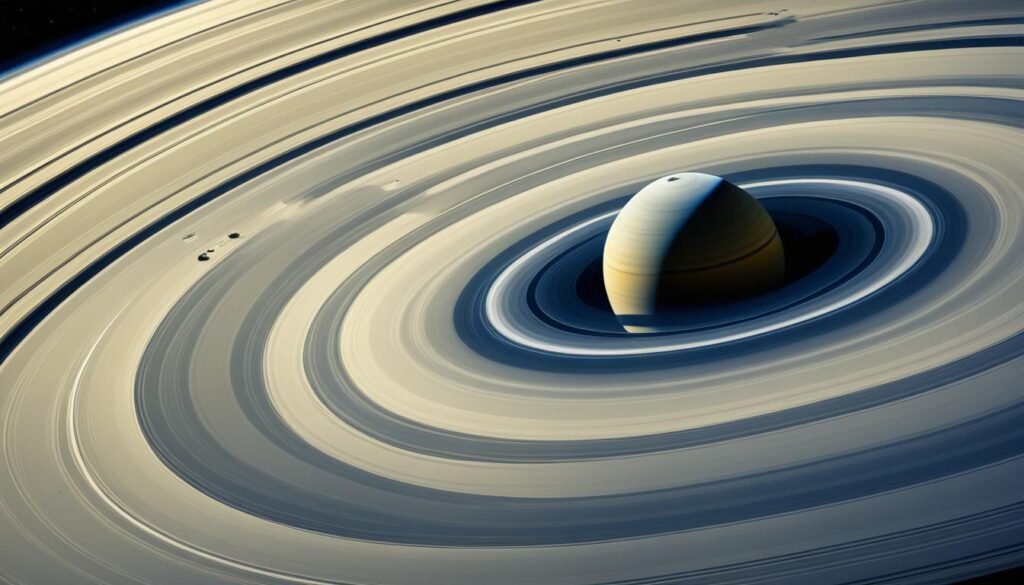
Create an image of the Cassini-Huygens spacecraft approaching the rings of Saturn, with the planet looming in the distance. Show the spacecraft’s instruments as they gather data on the composition and structure of the rings. Use vibrant colors to convey the awe-inspiring nature of this monumental moment in space exploration.
Our adventure around Saturn revealed many wonders. Did you know Saturn is more than nine times bigger than Earth? Its equatorial radius is even more impressive, stretching around 60,268 km.
Looking at Saturn’s poles, we found its shape stands out. Its polar radius is around 54,364 km. Despite its size, Saturn is lighter than water. This tells us it’s mostly gas.
| Parameter | Value | Comparison to Earth |
|---|---|---|
| Average Radius | 58,232 km | 9.1402 times Earth’s size |
| Equatorial Radius | 60,268 km | 9.449 times Earth’s size |
| Polar Radius | 54,364 km | 8.552 times Earth’s size |
| Mass | 5.6834 x 1026 kg | 95.159 times Earth’s mass |
| Surface Gravity | 10.44 m/s2 | 1.065 times Earth’s gravity |
| Escape Velocity | 35.5 km/s | — |
| No. of Satellites | 146 | — |
Saturn is heavy, about 95 times Earth’s mass. Yet, its gravity is only slightly stronger than Earth’s. The planet is mostly hydrogen and helium. A few other elements are mixed in too.
The rings around Saturn are iconic. They’re made of ice and rock. Saturn’s rings and moons were shaped by its strong magnetic field. Cassini-Huygens showed us winds there can hit 1,800 km/h. A day on Saturn is just over 10.5 hours long.
Exploring Saturn’s rings and its moons was special. Thanks to Cassini-Huygens, we saw Saturn’s greatness up close. This mission will always be remembered by space lovers everywhere.
Dragonfly: The Next Leap in Saturn’s Moon Exploration
The Dragonfly mission represents a giant leap forward in space exploration. It targets Titan, Saturn’s largest moon. This mission promises to revolutionize our knowledge. The 2026 launch is highly anticipated by scientists and enthusiasts alike. This exploration will be marked by the first-ever multi-rotor flight on another world. Dragonfly’s advanced design showcases a major advancement in extraterrestrial flight technology.
Pioneering Multi-rotor Flight on Another World
After a rigorous two-and-a-half-year selection process, Dragonfly emerged as a winner. It’s not just a spacecraft but a robotic pioneer. With its eight powerful rotors, it will glide over Titan’s lands. This offers a unique way to explore alien terrain. Just imagine it jumping from dune to dune!
Preparing for the Groundbreaking Insights of the 2034 Arrival
Dragonfly is set to explore Titan for two and a half years after it arrives in 2034. Its mission goes beyond simple exploration. It aims to dive into Titan’s astrobiology and organic chemistry. We’re building on the legacy of the Huygens probe. Our goal is to understand the potential for life far from Earth.
Details of the Dragonfly spacecraft:
- It’s about 3 meters long and over a meter tall
- It has a unique dual set of four rotors for multi-rotor flight
- It will send images of its flight back to Earth
- It recharges using a radioactive source between flights
Insights into Titan:
- It has a chilly surface temperature of 94 K (-290°F/-179°C)
- Its atmosphere is four times denser than Earth’s
- Its low gravity is perfect for flying
Mission Objectives:
- To analyze amino acids and organic materials
- To explore over 100 kilometers to Selk crater for potential life-supporting environments
- It will travel eight kilometers per leap
As the 2034 space mission approaches, our hopes soar as high as Dragonfly’s future flights. The information it will send back is sure to deepen our universe understanding. This mission proves our unending quest to explore and understand the vast cosmos. Dragonfly marks another step in our journey through the solar system.
Beholding Saturn’s Rings: A Window into Planetary Formation
Since Galileo Galilei first saw Saturn’s rings, calling them “not a single star but three together,” our journey of discovery has not stopped. These rings show us Saturn’s complex system. They invite us into the story of how space things evolve.
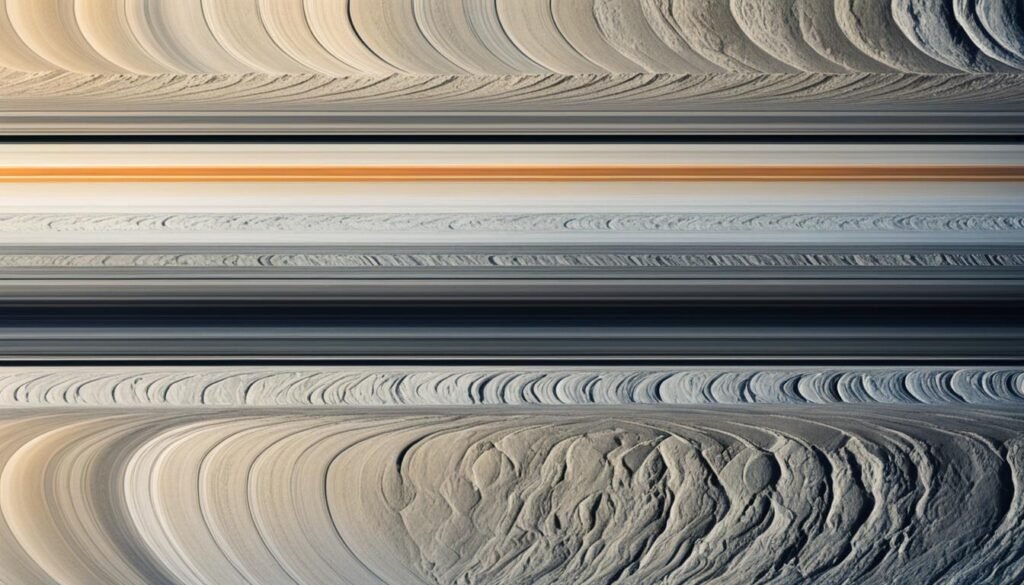
Create an image of Saturn’s ring system as seen from above, showing the intricate patterns and textures of the different rings. The colors should accurately reflect the composition of each ring, with blues and greens for the icy rings and browns and oranges for the rocky ones. The image should also showcase the shadows cast by the rings onto Saturn’s surface, adding depth and dimension to the scene. The planet itself should be visible in the background, but the focus should be on the stunning beauty and complexity of its ring system.
The Hubble was launched in 1990. Even with its initial mirror issue, it opened a new window into space after 1993. Its corrected vision brought us close-up views of distant cosmic wonders. We saw Saturn’s rings in stunning detail, offering hints about how planets form.
The Enigma of the Rings’ Existence
Saturn’s rings are a massive dance of gravity. About 30 quintillion kilograms of ice particles move in this dance. This movement is a story of building up and breaking down, showing Saturn’s big influence. Even Herbert Armstrong connected these rings with human destiny, showing our deep fascination.
Exposing the Complexity of Saturn’s Ring System
In 2009, the Cassini probe gave us animations of Earth with rings like Saturn’s. These images, inspired by artists like Ron Miller and Roy Prol, mix science with imagination. This blending of art and science shows how we can give life to quiet worlds, echoing Gerald Flurry’s views on telescope findings and biblical insights.
Thinking about Saturn’s rings does more than fill academic curiosity. It’s an invitation to explore the creation of these space wonders. Every new picture or fact brings us closer to understanding our universe. It encourages us to keep exploring Saturn’s rings and the endless mysteries of space.
The unique hexagon weather pattern at Saturn’s north pole is fascinating. It shows us just how complex and wonderful Saturn is. Despite being hundreds of millions of miles away, we bridge this distance. We do it with powerful telescopes and brave space probes aiming to unlock space secrets.
Every mission gets us closer to understanding Saturn, uncovering its past, present, and the future we’re excited to see. Our dedication to exploring Saturn shows our commitment to growing our collective knowledge. It highlights our quest to explore the vast universe that Saturn calls home.
FAQ
What are some fascinating Saturn facts?
Saturn is famous for its beautiful rings and many moons, like Titan and Enceladus. It’s a giant planet made mostly of hydrogen and helium. It’s the second-largest in our solar system. It also has the biggest ring system around it.
Who discovered Saturn, and what is Saturn’s history of exploration?
People have known about Saturn for a long time. Galileo Galilei was the first to look at it through a telescope in 1610. After him, scientists like Christiaan Huygens and Jean-Dominique Cassini gave us more details about its rings and moons. The way we explore Saturn changed with missions like Voyager and Cassini-Huygens.
What is Saturn’s composition and atmosphere like?
Saturn is mostly hydrogen and helium with a bit of other elements. It has yellow and gold bands because of fast winds and interior heat. These create its unique striped look.
How cold or hot is Saturn and how big is it compared to Earth?
Saturn is very cold, with an average temperature of -285 degrees Fahrenheit. It’s huge, 755 times bigger than Earth by volume. It’s so light for its size, it could float if there was a big enough water pool.
What makes Saturn’s rings so special?
Saturn’s rings are mostly water ice with some rock. They are incredibly vast, complex, and always changing due to Saturn’s moons’ gravity. They include detailed structures like braided rings, showing their complexity.
How many moons does Saturn have, and are they all the same?
Saturn has 82 moons, each different from the others. Titan has a thick atmosphere, and Enceladus has hydrothermal activity. They show us diverse aspects of planetary science.
What was the Huygens Probe’s significance in the study of Titan?
The Huygens Probe was the first to land on Titan. It showed us Titan’s complicated landscape and atmosphere, loaded with organic molecules. These discoveries are essential for learning about possible life-supporting places and Titan’s geological activities.
What did the Pioneer 11 and Voyager missions contribute to our knowledge of Saturn?
Pioneer 11 showed us Saturn’s faint magnetic field. Voyager missions added new moons to our lists and showed us the rings in detail. They changed how we see Saturn and its role in the solar system.
What were the Cassini-Huygens mission’s key discoveries?
The Cassini-Huygens mission told us a lot about Saturn’s inside, its air, and its moons. It watched the planet change with seasons, saw how the rings move, and studied Titan’s ground. This told us much more about Saturn.
What is the purpose of the upcoming Dragonfly mission to Titan?
The Dragonfly mission will explore Titan by flying around it. It will check out places like dunes and craters, arriving in 2034. The mission wants to understand Titan’s chemistry and geology. This can help us learn about astrobiology and how planets start.
Why are Saturn’s rings a vital subject for space research?
Saturn’s rings help us learn about how planets form and their nearby spaces. By studying them, we get into the gravitational forces and material building up in our solar system.
What is Saturn’s distance from Earth, and can we see the hexagon on its north pole?
Saturn is between 746 million and 1 billion miles away from us, depending on where we both are in our orbits. The hexagon on its north pole, a strange weather pattern, can’t be seen without special equipment. Voyager and Cassini gave us a close look at it.

